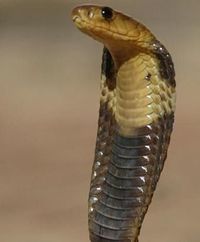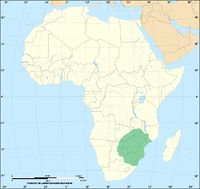Snouted cobra: Difference between revisions
imported>Francis Zaia No edit summary |
imported>Francis Zaia No edit summary |
||
| Line 38: | Line 38: | ||
==Taxonomy== | ==Taxonomy== | ||
It was formerly considered a subspecies of the [[Egyptian Cobra]] ''Naja haje'', and the [[Anchieta's cobra]] (''Naja anchietae'') was also formerly considered to be a subspecies of the latter species and later this species, before being split as a distinct species. | It was formerly considered a subspecies of the [[Egyptian Cobra]] ''Naja haje'', and the [[Anchieta's cobra]] (''Naja anchietae'') was also formerly considered to be a subspecies of the latter species and later this species, before being split as a distinct species. | ||
==Etymology== | |||
The snouted cobra was first described by [[Germany|German]] naturalist Wilhelm Peters in 1854.<ref>Peters,W.C.H. 1854. Diagnosen neuer Batrachier, welche zusammen mit der früher (24. Juli und 17. August) gegebenen Übersicht der Schlangen und Eidechsen mitgetheilt werden. Ber. Bekanntmach. Geeignet. Verhandl. Königl.-Preuss. Akad. Wiss. Berlin 1854: 614-628</ref> The [[genus|generic]] name ''naja'' is a Latinisation of the [[Sanskrit]] word '''nāgá''' ({{lang|sa|[[:wikt:नाग#Sanskrit|नाग]]}}) meaning "cobra". The [[species|specific]] epithet ''annulifera'' means "ringed animal" and comes from the [[Latin]] words "annulus" which means ''ring'' or ''band'' and "fera" which means "animal" or "wild beast". | |||
==Description== | ==Description== | ||
Revision as of 15:32, 23 May 2012
| Snouted cobra | ||||||||||||||||||||
|---|---|---|---|---|---|---|---|---|---|---|---|---|---|---|---|---|---|---|---|---|
 Snouted cobra
| ||||||||||||||||||||
| Scientific classification | ||||||||||||||||||||
| ||||||||||||||||||||
| Binomial name | ||||||||||||||||||||
| Naja annulifera Peters, 1854[1][2] | ||||||||||||||||||||
 Distribution of the Snouted cobra
| ||||||||||||||||||||
| Synonyms | ||||||||||||||||||||
|
The snouted cobra (Naja annulifera) also known as the Banded cobra, is a species of venomous snake belonging to the family Elapidae and is native to parts of southern Africa.
Taxonomy
It was formerly considered a subspecies of the Egyptian Cobra Naja haje, and the Anchieta's cobra (Naja anchietae) was also formerly considered to be a subspecies of the latter species and later this species, before being split as a distinct species.
Etymology
The snouted cobra was first described by German naturalist Wilhelm Peters in 1854.[3] The generic name naja is a Latinisation of the Sanskrit word nāgá (नाग) meaning "cobra". The specific epithet annulifera means "ringed animal" and comes from the Latin words "annulus" which means ring or band and "fera" which means "animal" or "wild beast".
Description
The snouted cobra is a relatively large species of cobra. Adult specimens average between 1.2 m (3.94 ft) to 1.8 m (5.91 ft) in length but they may reach lengths of 2.5 m (8.2 ft). Colouration of dorsal scales may vary from yellowish to greyish brown, dark brown or blue-black. Ventral scale colouration is yellow with darker mottles. A banded phase occurs throughout the species' range and is blue-black with 7-11 yellow to yellow-brown cross bars, the lighter bands being half the width of the darker bands. The latter colour phase is more common in males. Ventrally, yellow mottled with black. A darker throat band is present and is usually more prominent in juveniles.[4]
Scalation
Midbody scales are in 19 rows (rarely 21) with 175-203 ventrals. There are 51-65 paired subcaudals and the anal shield is entire. There are 7 (sometimes 8) upper labials that do not enter the eye, 8 or 9 (rarely 10) lower labials, as well as 1 pre-ocular (sometimes 2) and 2 (sometimes 1 or 3) post-oculars. Temporals are variable, 1+2 or 1+3.[4]
Distribution
This species is found in northeast South Africa, southern Mozambique, eastern Botswana, Malawi, throughout Zimbabwe, and parts of Swaziland.[5]
Habitat and ecology
Snouted cobras inhabit arid and moist savanna, particularly in bushveld and lowveld areas. It is not found in forests. As a large cobra, it likes to have a permanent home base or lair in an abandoned termite mound where it will reside for years if left undisturbed. It is a nocturnal species, foraging for food from dusk onwards, often venturing into poultry runs. It enjoys basking in the sun during the day near its lair or retreat. Not a particularly aggressive species, but will assume a formidable posture if cornered. Very large adults are able to lift as much as half a metre of the body off the ground while spreading a wide, impressive hood. However, given the opportunity it will escape to the nearest hole or crevice. Like the Rinkhals it may sham death if threatened, but this is rare. It preys on toads, rodents, birds and their eggs, lizards and other snakes, especially puff adders (Bitis arietans). It often raids poultry runs and can become a nuisance. It is preyed upon by birds of prey and other snakes.[4]
Reproduction
This is an oviparous species, laying between 8 and 33 eggs in early summer. The young average 22 and 34 cm (8.7 and 13 in) in length.[4]
Venom
It is a highly venomous species with neurotoxic venom. A bite can affect breathing and if left untreated may cause respiratory failure and death. Initial symptoms include pain and local swelling that may result in blistering. Typically, victims are bitten on the lower leg, usually at night.[4]
Cited references
- ↑ Naja annulifera (TSN 700625) at Integrated Taxonomic Information System. Accessed 11 May 2012.
- ↑ Naja annulifera PETERS, 1854 a The Reptile Database. Accessed 11 May 2012.
- ↑ Peters,W.C.H. 1854. Diagnosen neuer Batrachier, welche zusammen mit der früher (24. Juli und 17. August) gegebenen Übersicht der Schlangen und Eidechsen mitgetheilt werden. Ber. Bekanntmach. Geeignet. Verhandl. Königl.-Preuss. Akad. Wiss. Berlin 1854: 614-628
- ↑ 4.0 4.1 4.2 4.3 4.4 Marais, Johan (2004). A Complete Guide to the Snakes of Southern Africa. Cape Town, South Africa: Struik Nature, 102–103. ISBN 1-86872-932-X.
- ↑ Naja annulifera - General Details, Taxonomy and Biology, Venom, Clinical Effects, Treatment, First Aid, Antivenoms. WCH Clinical Toxinology Resource. University of Adelaide. Retrieved on 19 January 2012.